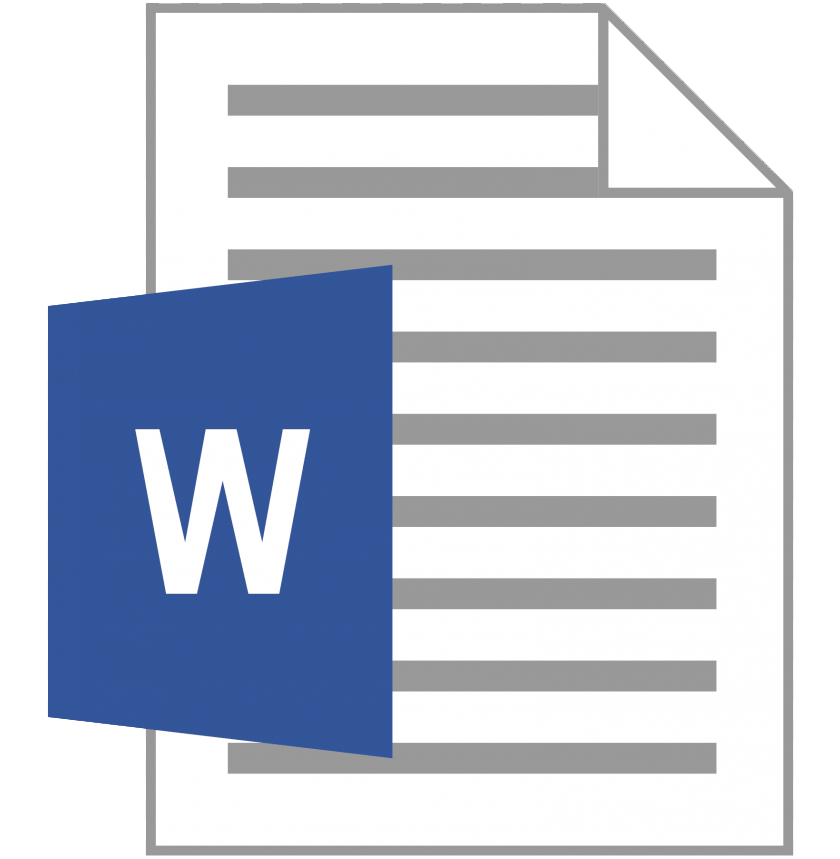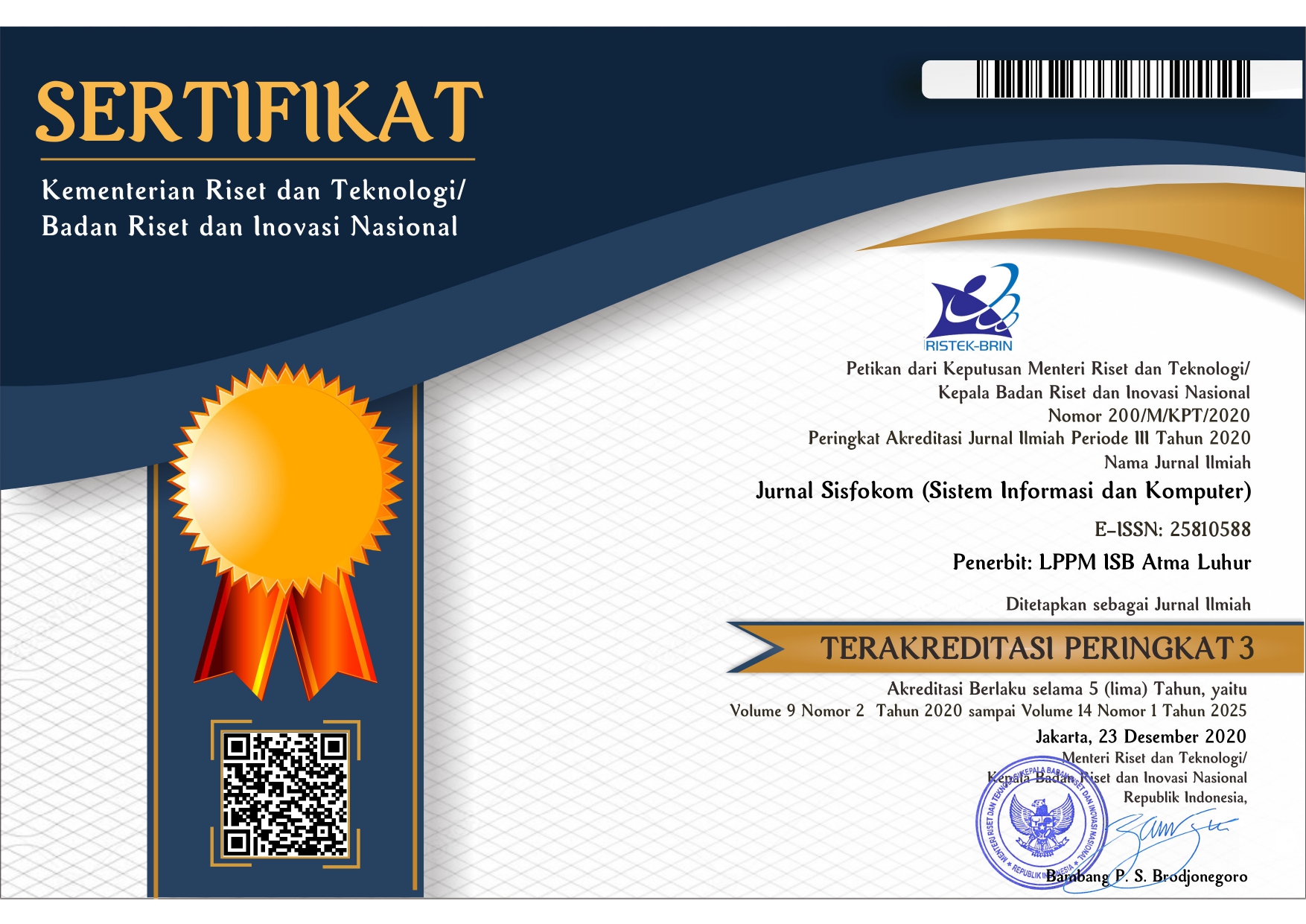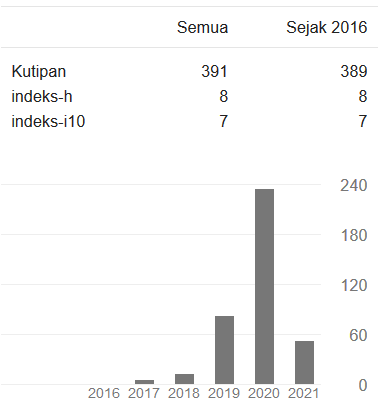INTEGRASI DATA MINING DAN ONLINE ANALYTICAL PROCESSING (OLAP) PADA DATA PERFORMA SISWA
DOI:
https://doi.org/10.32736/sisfokom.v9i3.1022Keywords:
Data Mining, On-Line Analytical Processing, Power OLAPAbstract
Pertumbuhan teknologi membawa dampak terhadap peningkatan data untuk digunakan bagi setiap orang. Akumulasi data tersebut telah menciptakan pola data yang semakin banyak, namun perolehan informasi dari data tersebut masih minim. Oleh karena itu, saat ini diperlukan suatu teknik analisa data dalam mencari pola dari kumpulan data tersebut, salah satunya adalah data mining. Data mining merupakan proses pencarian informasi baru dari kumpulan data yang besar untuk menemukan informasi baru sebagai bahan pertimbangan dalam pengambilan keputusan di berbagai bidang, seperti bidang pendidikan. Dalam bidang pendidikan, banyak menghasilkan berbagai macam data, seperti data performa siswa dalam persiapan mengikuti ujian. Data tersebut dapat dianalisis dengan menggunakan metode On-Line Analytical Processing (OLAP) untuk menemukan pola dari data performa siswa tersebut. Penelitian ini berfokus pada proses integrasi data mining yang terdiri dari association, clustering, classification dan forecasting dengan kombinasi metode On-Line Analytical Processing (OLAP) pada data performa siswa. Penulis juga menggunakan bantuan tools Power OLAP untuk membantu analisa metode data mining. Hasil dari penelitian ini adalah penemuan pola baru dalam proses identifikasi kelompok data tersebut, seperti informasi mengenai rata-rata hasil ujian siswa berdasarkan persiapan ujian yang dilakukan dalam bentuk grafik sebagai alat pemodelan dari data, sehingga pengetahuan baru tersebut dapat membantu pihak universitas/sekolah untuk melalukan klasifikasi mengenai tingkat kelulusan dan dapat menetukan strategi dalam meningkatkan kelulusan siswa pada tahun - tahun berikutnya.References
A. Asroni, H. Fitri, and E. Prasetyo, “Penerapan Metode Clustering dengan Algoritma K-Means pada Pengelompokkan Data Calon Mahasiswa Baru di Universitas Muhammadiyah Yogyakarta (Studi Kasus: Fakultas Kedokteran dan Ilmu Kesehatan, dan Fakultas Ilmu Sosial dan Ilmu Politik),” Semesta Tek., vol. 21, no. 1, pp. 60–64, 2018, doi: 10.18196/st.211211.
G. Indrawan and G. R. Dantes, “Data Mining Rekomendasi Calon Mahasiswa Berprestasi di STMIK Denpasar Menggunakan Metode Technique for Others Reference by Similarity to Ideal Solution,” J. Sains dan Teknol., vol. 5, no. 2, pp. 746–760, 2016.
S. Haryati, A. Sudarsono, and E. Suryana, “Implementasi Data Mining Untuk Memprediksi Masa Studi Mahasiswa Menggunakan Algoritma C4.5 (Studi Kasus: Universitas Dehasen Bengkulu),” J. Media Infotama, vol. 11, no. 2, pp. 130–138, 2015.
Agus Nur Khormarudin, “Teknik Data Mining: Algoritma K-Means Clustering,” J. Ilmu Komput., pp. 1–12, 2016, [Online]. Available: https://ilmukomputer.org/category/datamining/.
A. Muzakir and R. A. Wulandari, “Model Data Mining sebagai Prediksi Penyakit Hipertensi Kehamilan dengan Teknik Decision Tree,” Sci. J. Informatics, vol. 3, no. 1, pp. 19–26, 2016, doi: 10.15294/sji.v3i1.4610.
D. S. Susilawati and D. Riana, “Optimization the Naive Bayes Classifier Method to Diagnose Diabetes Mellitus,” IAIC Trans. Sustain. Digit. Innov., vol. 1, no. 1, pp. 78–86, 2019, doi: 10.34306/itsdi.v1i1.21.
B. Karim, S. Sentinuwo, and A. Sambul, “Penentuan Besaran Uang Kuliah Tunggal untuk Mahasiswa Baru di Universitas Sam Ratulangi Menggunakan Data Mining,” J. Tek. Inform., vol. 11, no. 1, pp. 1–9, 2017, doi: 10.35793/jti.11.1.2017.16555.
G. Singh and B. Kishore, “Comparative Analysis of Opinion Mining KDD for Customer Reviews,” Int. J. Res. Eng. Sci. Manag., vol. 2, no. 8, pp. 15–17, 2019.
F. A. Rahman, S. M. Shamsuddin, S. Hasan, and N. A. Haris, “A Review of KDD Data Mining Framework and Its Application in Logistics and Transportation,” Int. J. Supply Chain Manag., vol. 5, no. 2, pp. 77–84, 2016.
B. Salimi, C. Cole, P. Li, J. Gehrke, and D. Suciu, “HypDB: A Demonstration of Detecting, Explaining and Resolving Bias in OLAP Queries,” Proc. VLDB Endow., vol. 11, no. 12, pp. 2062–2065, 2018, doi: 10.14778/3229863.3236260.
C. Zhan et al., “AnalyticDB: Real-Time OLAP Database System at Alibaba Cloud,” Proc. VLDB Endow., vol. 12, no. 12, pp. 2059–2070, 2018, doi: 10.14778/3352063.3352124.
P. Nahar and S. Kumar, “Developing a Decision Support System (DSS) for Utility of Power Supply Organization,” Int. J. Appl. Eng. Res., vol. 12, no. 9, pp. 1962–1968, 2017.
J. R. Informasi, N. Wulandari, and P. Etikasari, “Analisis Minat Belajar Siswa pada Lembaga Pendidikan Pendidikan Indonesia Amerika Perumnas 3 Bekasi dengan Metode c4.5,” J. Rekayasa Inf., vol. 8, no. 1, pp. 22–31, 2019.
F. Yunita, “Penerapan Data Mining Menggunkan Algoritma K-Means Clustring Pada Penerimaan Mahasiswa Baru,” J. Sist., vol. 7, no. 3, p. 238, 2018, doi: 10.32520/stmsi.v7i3.388.
K. Fatmawati and A. P. Windarto, “Data Mining: Penerapan Rapidminer Dengan K-Means Cluster Pada Daerah Terjangkit Demam Berdarah Dengue (Dbd) Berdasarkan Provinsi,” Comput. Eng. Sci. Syst. J., vol. 3, no. 2, p. 173, 2018, doi: 10.24114/cess.v3i2.9661.
F. Firat, A. K. Arslan, C. Colak, and H. Harputluoglu, “Estimation of Risk Factors Associated With Colorectal Cancer: An Application of Knowledge Discovery in Databases,” Kuwait J. Sci., vol. 43, no. 2, pp. 151–161, 2016.
R. Yanto and H. Di Kesuma, “Pemanfaatan Data Mining Untuk Penempatan Buku Di Perpustakaan Menggunakan Metode Association Rule,” JATISI (Jurnal Tek. Inform. dan Sist. Informasi), vol. 4, no. 1, pp. 1–10, 2017, doi: 10.35957/jatisi.v4i1.83.
D. P. Utomo and M. Mesran, “Analisis Komparasi Metode Klasifikasi Data Mining dan Reduksi Atribut Pada Data Set Penyakit Jantung,” J. Media Inform. Budidarma, vol. 4, no. 2, p. 437, 2020, doi: 10.30865/mib.v4i2.2080.
A. Lamani, B. Erraha, M. Elkyal, and A. Sair, “Data Mining Techniques Application for Prediction in OLAP Cube,” Int. J. Electr. Comput. Eng., vol. 9, no. 3, pp. 2094–2102, 2019, doi: 10.11591/ijece.v9i3.pp2094-2102.
M. P. Cristescu, “Using OLAP Data Cubes in Business Intelligence,” Sci. Bull., vol. 21, no. 2, pp. 80–86, 2017, doi: 10.1515/bsaft-2016-0039.
R. Andreswari and M. A. Rasyid, “OLAP Cube Processing of Production Planning Real-life Event Log: A Case Study,” Atl. Highlights Eng., vol. 2, pp. 148–153, 2019.
W. Jakawat, C. Favre, and S. Loudcher, “OLAP Cube-Based Graph Approach for Bibliographic Data,” CEUR Workshop Proc., vol. 1548, pp. 87–99, 2016.
Neha and K. Garg, “Efficient Information Retrieval Using Multidimensional OLAP Cube,” Int. Res. J. Eng. Technol., vol. 4, no. 7, pp. 2885–2889, 2017.
L. Gomez, B. Kuijpers, and A. Vaisman, “Performing OLAP Over Graph Data: Query Language, Implementation, and a Case Study,” ACM Int. Conf. Proceeding Ser., pp. 1–8, 2017, doi: 10.1145/3129292.3129293.
H. Sulistiani and D. Darwis, “Penerapan Metode Agile untuk Pengembangan Online Analytical Processing (OLAP) pada Data Penjualan (Studi Kasus : CV Adilia Lestari),” J. CoreIT, vol. 6, no. 1, pp. 50–56, 2020.
N. Shaik, W. Ullah, and G. Pradeepni, “OLAP Mining Rules: Association of OLAP with Data Mining,” Am. J. Eng. Res., vol. 5, no. 2, pp. 2320–847, 2016, [Online]. Available: www.ajer.org.
S. Hendrian, “Algoritma Klasifikasi Data Mining Untuk Memprediksi Siswa Dalam Memperoleh Bantuan Dana Pendidikan,” Fakt. Exacta, vol. 11, no. 3, pp. 266–274, 2018, doi: 10.30998/faktorexacta.v11i3.2777
Downloads
Published
Issue
Section
License
The copyright of the article that accepted for publication shall be assigned to Jurnal Sisfokom (Sistem Informasi dan Komputer) and LPPM ISB Atma Luhur as the publisher of the journal. Copyright includes the right to reproduce and deliver the article in all form and media, including reprints, photographs, microfilms, and any other similar reproductions, as well as translations.
Jurnal Sisfokom (Sistem Informasi dan Komputer), LPPM ISB Atma Luhur, and the Editors make every effort to ensure that no wrong or misleading data, opinions or statements be published in the journal. In any way, the contents of the articles and advertisements published in Jurnal Sisfokom (Sistem Informasi dan Komputer) are the sole and exclusive responsibility of their respective authors.
Jurnal Sisfokom (Sistem Informasi dan Komputer) has full publishing rights to the published articles. Authors are allowed to distribute articles that have been published by sharing the link or DOI of the article. Authors are allowed to use their articles for legal purposes deemed necessary without the written permission of the journal with the initial publication notification from the Jurnal Sisfokom (Sistem Informasi dan Komputer).
The Copyright Transfer Form can be downloaded [Copyright Transfer Form Jurnal Sisfokom (Sistem Informasi dan Komputer).
This agreement is to be signed by at least one of the authors who have obtained the assent of the co-author(s). After submission of this agreement signed by the corresponding author, changes of authorship or in the order of the authors listed will not be accepted. The copyright form should be signed originally, and send it to the Editorial in the form of scanned document to sisfokom@atmaluhur.ac.id.






